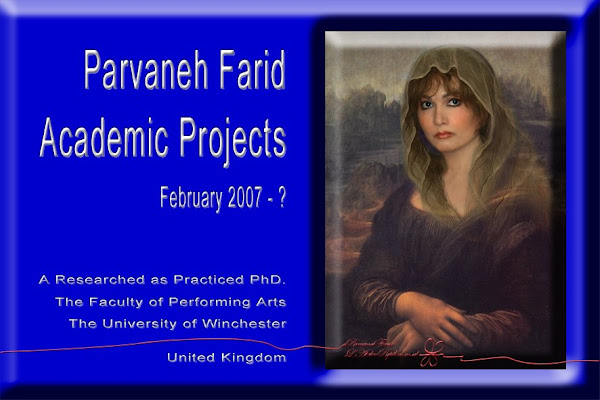Friday, 26 April 2013
Translating the Lines - Symposium Presentation Paper 26th April 2013
http://www.youtube.com/watch?v=JA-mBKmayDc
Parvaneh Farid
A PhD candidate
The Department of Art
The University of Winchester
26th April 2013
Supervisors: Prof. June
Boyce-Tillman and Dr Olu Taiwo
Abstract: Breaking through the fear of translating the lines of one art
format into another provides the artist with an opportunity to find
him/her-self in a virgin world of possibilities. It allows the artist to feel
free to see, free to be one-self, and to create in an innovative manner,
regardless of what is expected of her/him. That is partially due to being a
beginner in a new field which has not imprinted its norms on his/her
mind.
Let’s begin by defining the
following terms; “the Invisible & Visible Lines”
·
Invisible Line: the
invisible path of the movement of a phenomenon from one position to another
which is documented on the canvas of our memory
· Visible Line: the
documentation of the path of an invisible line by means of technology; e.g. pen
and paper
The human appears to have an
innate urge to prove his/her unique sense of being to himself as well as to his
environment –others-. Perhaps this is what Abraham Maslow refers to as “Self
Actualisation” in his “Pyramid of Human Needs”.
To respond to that urge/need, a
human constantly communicates with himself as well as with others through translating
his invisible lines of thoughts and feelings which emerge from his perception to
a set of expressive lines of sound and movement.
The trace of these invisible
lines of sound and movement, as they are performed, are documented on the “Canvas
of our Memory” as “Invisible Lines of Memory”. The latter could then
be translated to some “Visible Lines” by means of technology - in its
simplest form; pen and paper.
The Language of the Art is born
when these visible and invisible lines become stylised in their aesthetic form
of both performance and technique of documentation by the use of metaphors,
symbols and imagination. The manner of performance and the recording techniques
then determine the category of the relevant art format they belong to.
If we agree that the platform
of creation of all art formats is human perception, we can then argue that the
invisible lines of expressing those perceptions and the visible lines of their
documentation could be translated to one another, simply because they are from
the same origin.
My hypothesis is whether or not
translating the lines of one art format to another could provide the artist
with a space for further innovation and more agile creativity. In other words a
dialectic process may take place during the course of translation of one
format/thesis to another/antithesis, which could give birth to a synthesis of
an innovative style.
To study that, we may look at
the visible and invisible lines of thought and figurative poetry of three
Persian female poetesses of the mid 19th to 20th century.
1. Tahirih - Qurratu'l-`Ayn - Fátimih Baraghání (1814 or 1817 – 1852)
2. Parvin Etesami (1907 – 1941)
3. Forough Farrokhzad (1935 - 1967)
All
three of them died in their thirties and each one of them is regarded as being
a turning point in the history of the liberation of women in Iran for a
particular reason.
Tahirih has put her
stamp on history for being the first woman who publicly removed her veil,
saying: "You can kill me
as soon as you like, but you cannot stop the emancipation of women". She was executed by the government for being an
active member of an Iranian based religious movement; Babi, which progressed
into today’s Baha’i Faith founded in 19th century Iran.
It is notable that although Tahirih could be
regarded as the pioneer for the work of the other two poetesses, it is not
until Forough appears on the scene that a feminine language finds its way into
Persian poetry. Up until then the Persian poetesses even like Tahirih wrote
their words as a man would describe and praise his female lover. Parvin’s
poetic language, however, was neither this nor that. The solution which Parvin
found was to act as an asexual narrator who simply reports a dialogue between
two persons who would represent some social characters; in this instance a
nomad and a Sheriff.
During the course of this
practice based research three poems have been chosen, one poem by each of these
poetesses:
“The Bird of Heart” by
Tahirieh, “A Nomad and the Sherif” by Parvin and “Another Birth” by Forough. An
attempt has then been made to translate the invisible lines of their
perceptions and the visible lines of their expressions to visible lines of
“Designed Persian Calligraphy, Narrative Photomontage, and Freehand Drawing as
well as Digital.
The onlookers are asked to
kindly express their opinion as to whether they agree with this hypothesis and
why.
Subscribe to:
Comments (Atom)

